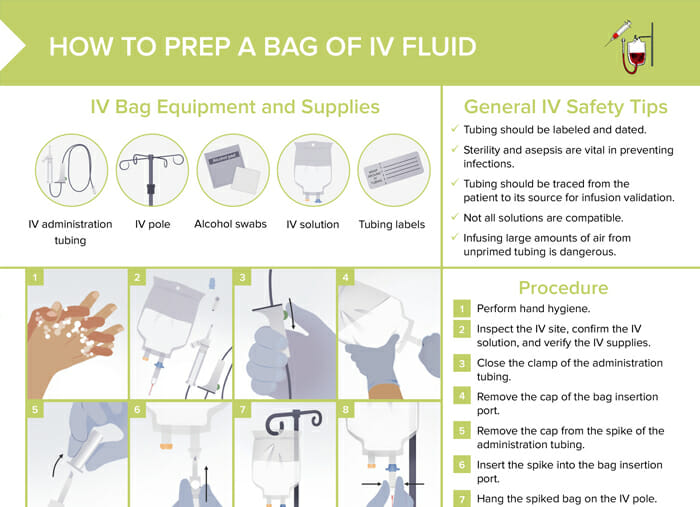What is IV fluid?
IV fluid is a liquid directly infused into a patient’s bloodstream via a vein, often to maintain hydration, correct electrolyte imbalances, or deliver medications. There are different types of IV fluids, such as normal saline (0.9% sodium chloride) and lactated Ringer’s, chosen based on the patient’s specific needs.
What supplies are needed for IV fluid administration?
Supplies needed to start IV fluid administration are:
- IV administration bag
- IV pole
- Alcohol swabs
- IV solution
- Tubing labels
How to prep a bag of IV fluid
- Perform hand hygiene.
- Inspect IV site, confirm correct IV solution, and verify supplies.
- Close the clamp of the administration tubing.
- Remove the cap of the bag insertion port.
- Remove the cap from the spike of the administration tubing.
- Insert the spike into the bag insertion port.
- Hang the spiked bag on the IV pole.
- Squeeze the drip chamber until it is half full.
- Aim the distal end of the IV tubing over a sink or trash bin.
- Open the IV tubing roller clamp and make sure the slide clamp is open.
- To prime the tubing, open the roller clamp and side clamp to allow the fluid to flow until all the air is gone.
- Close the roller clamp.
- Attach to the pump or flow control; program the IV infusion pump rate.
- Label the tubing and connect the tubing to the IV site.
How long do IV hydration fluids stay in the body?
Generally, half of isotonic fluids may be excreted in about 1–2 hours after infusion; however, this can vary widely. The duration IV fluids stay in the body depends on various factors, including:
- Hydration status of the client previous to the IV fluid
- The client’s kidney function status
- The type of IV fluid
How long does IV hydration last?
IV hydration can be effective for very varied durations: from several hours for a well-hydrated client to only transient effects in clients with ongoing fluid losses.
How much IV fluid is needed for dehydration?
The amount of IV fluid required for dehydration varies based on the severity of dehydration, the patient’s weight, and underlying conditions.
For adults, typically 2-3L of isotonic solution (e.g., normal saline or lactated Ringer’s) over 24 hours might be given to mildly dehydrated clients. For moderate to severe dehydration, give an initial bolus of 500 mL to 1L of isotonic fluid over 1 hour, then reassess. Total fluid needs over 24 hours could range from 3–6L, or more. Adding maintenance fluids would be another 25–30 mL/kg/day.
For children, the approach is weight-based, and the amount of fluid is often calculated based on the estimated percentage of weight lost due to dehydration.
What IV fluid is best for dehydration?
The most commonly used IV fluids for dehydration are isotonic solutions (normal saline, lactated Ringer’s, or 5% dextrose in water for maintenance hydration). The decision is made based on the client’s electrolyte levels and clinical status.
Why is priming important?
Priming refers to filling the IV tubing with the fluid from the bag to ensure there are no air bubbles present in the line before it’s connected to the patient. Risks of not properly priming the tubing include:
- Air embolism (can be life-threatening if larger amount of air)
- Less effective treatment due to interrupted flow of medication or fluid
- Altered drip rate
What is an IV fluid bolus?
An IV bolus is the rapid infusion of a certain amount of IV fluid within a short period of time. This is often done in situations where the circulating volume needs to be quickly increased (such as hypovolemia or hypotension), or a medication needs to be delivered quickly.
Can an RN start an IV hydration business?
The short answer: Yes, depending on your location.
In many states, RNs do not need a physician’s oversight to administer IVs, so could start an IV hydration business on their own; while in others, you would need a medical director who is a physician to oversee the service. Check your state’s Nurse Practice Act regulations for this information.
General IV safety tips
- Tubing should be labeled and dated.
- Sterility and asepsis are vital in preventing infections.
- Tubing should be traced from the patient to its source for infusion validation.
- Not all solutions are compatible.
- Infusing large amounts of air from unprimed tubing is dangerous.

